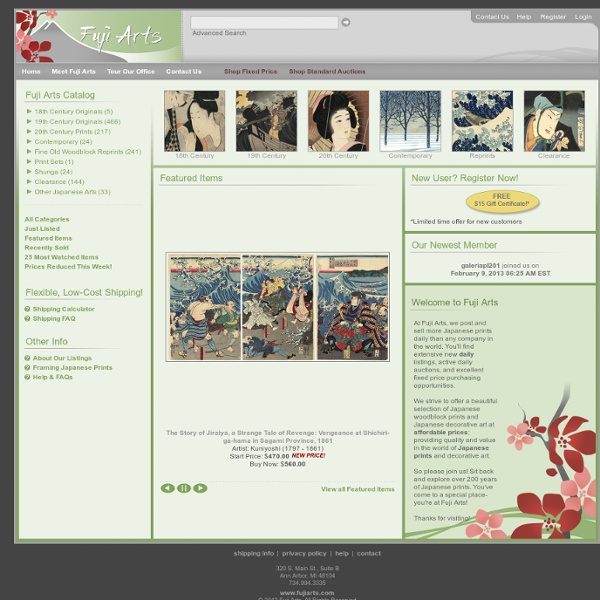



Thirty-six Views of Mount Fuji Thirty-six Views of Mount Fuji (富嶽三十六景, Fugaku Sanjūrokkei?) is an ukiyo-e series of large, color woodblock prints by the Japanese artist Katsushika Hokusai (1760–1849). The series depicts Mount Fuji in differing seasons and weather conditions from a variety of different places and distances. History[edit] The most famous single image from the series is widely known in English as The Great Wave off Kanagawa (神奈川沖浪裏, Kanagawa-oki nami-ura?) Each of the images was made through a process whereby an image drawn on paper was used to guide the cutting of a wood block. A collection of Thirty-six Views of Mount Fuji prints contained in the wellness spa of the Costa Concordia was lost during the collision of the ship on January 13, 2012.[3] All forty-six prints (the original thirty-six plus the ten additions) were featured in the exhibition "Hokusai: 36 Views of Mount Fuji" at the Freer Gallery of Art and the Arthur M. Prints[edit] Original thirty-six[edit] Additional 10[edit] Notes[edit]
The Fifty-three Stations of the Tōkaidō The Tōkaidō road, linking the shōgun's capital, Edo, to the imperial one, Kyōto, was the main travel and transport artery of old Japan. It is also the most important of the "Five Roads", the five major roads of Japan (Gokaidō), created or developed during the Edo era to further strengthen the control of the central shogunate administration over the whole country. Even though the Hōeidō edition is by far the best known, The Fifty-Three Stations of the Tōkaidō was such a popular subject that it led Hiroshige to create some 30 different series of woodcut prints on it, all very different one from the other by their size (ōban or chuban), their designs or even their number (some series include just a few prints). The Hōeidō edition of the Tōkaidō is Hiroshige's best known work, and the best sold ever ukiyo-e Japanese prints. The Tōkaidō[edit] Hiroshige and the Tōkaidō[edit] The Fifty-three Stations of the Tōkaidō (Hōeidō edition)[edit] Historical impact[edit] See also[edit] Notes[edit]
Tsukioka Yoshitoshi (1839-1892) Catalogue Raisonné Utagawa Kunisada, 'The Kabuki Actors Ichikawa Kodanji IV and Bandô Kamezô' Utagawa Kunisada (1786-1865)'The Kabuki Actors Ichikawa Kodanji IV and Bandô Kamezô'1856Nishiki-e (brocade print)Diptych, two ôban-size sheetsSignature: Tokokuni gaPublisher: DaikokuyaCensorship seals: aratame and Tatsu shichi (July 1856)Museum no. E.5733,5734-1886 This work is based on the final scene in Act 4 of 'Yoshitsune Senbon Zakura' (Yoshitsune and the Thousand Cherry Trees), performed at the Ichimura-za Theatre in July 1856. This print depicts a fight between the actor Ichikawa Kodanji IV as Fox-Genkuro and Kakuhan, a priest, among drifting will-o'-the-wisp. Kunisada frequently produced Kabuki prints. His detailed rendering of both actors and their costumes is particularly effective at capturing the liveliness and bustle of the performance. During the ukiyo-e printing process the paper was laid on the inked woodblock and rubbed on the back by a special tool known as a baren. This print can be found in Japanese Print Room Box JP2.
Utagawa Hiroshige II (1826-1869) Catalogue Raisonné Utagawa Kunisada (Toyokuni III) - Project s 'Tale of the Forty-Seven Rōnin' Introduction This page attempts to catalog all known prints in Yoshitoshi's 1860 series 'Tale of the Forty-Seven Rōnin ( Kanadehon chūshingura )' 1860. This is a very early series by Yoshitoshi, who was 21 years old at this time. The story of the forty-seven rōnin is one of the best known stories in Japanese literature. Forty-seven of Asano's samurai, led by Captain Oishi Kuranosuke, developed a plan to avenge their late master. You may be interested to read the account in " Tales of Old Japan ". This story has spawed many accounts, or Chushingura, and many kabuki plays, the most popular being 'Kanadehon Chushingura.' Technical details Dates: 4-6/1860Size: ChūbanSigned: Ikkaisai Yoshitoshi hitsuSeals: UnreadPublishers: MarujinBlock carvers: Previous cataloguings Roger. where it appears as series #21. This page (and list) is not necessarily complete; the series is not well documented, and there may be yet other prints which have not yet come to our attention. The Prints © Copyright 2009 by J.
Hiroshige Posthumes Porträt Hiroshiges von Kunisada, „Gedächtnisbild“, 1858 Utagawa Hiroshige (jap. 歌川 広重, alte Schreibung: 歌川 廣重, * 1797 in Edo (heute: Tokio); † 12. Oktober 1858), war zusammen mit Kuniyoshi und Kunisada einer der drei stilbildenden Meister des japanischen Farbholzschnitts am Ende der Edo-Zeit. Seine besondere Bedeutung liegt in einer völlig neuartigen Komposition des Landschaftsdruckes seiner Zeit und seinem maßgeblichen Einfluss auf die Entwicklung des europäischen Impressionismus. Im Westen ist er unter dem Namen Andō Hiroshige bekannt, einer fälschlich gebrauchten Kombination seines bürgerlichen Familiennamens Andō und dem ihm von seinem Lehrer verliehenen Künstlernamen Hiroshige, zu dem zwingend der Name der Schule Utagawa hinzugefügt werden muss. Lebensdaten[Bearbeiten] Hiroshige, bijin, Serie „Acht Ansichten - Frauen und Landschaften im Vergleich“, Anfang 1820er Im Februar 1809 starb Tokutarōs Mutter. Die Pflichten eines Feuerwehroffiziers in Edo zu Beginn des 19.
Kuniyoshi Project The Lavenberg Collection of Japanese Prints Japanese Prints Utagawa kuniyoshi and Kunisada Utagawa Kuniyoshi (1797 - April 14, 1861) was one of the last great masters of the Japanese ukiyo-e style of woodblock prints and painting and belonged to the Utagawa school. Read more. 47 ronin story One of the most famous stories of revenge in Japanese history comprises the exploits of the 47 Ronin (masterless samurai) who avenged the death of their lord in the early 18th century. In 1701, a feudal lord, Asano Naganori, was dishonored by Lord Kira, the Shogun's Master of Ceremonies. The group of the dishonored Asano's faithful samurai swore an oath to avenge his death. The Seichu gishi den was begun in August of 1847 and completed in January of 1848. Click these links for information on: The anatomy of the prints and censors seals.